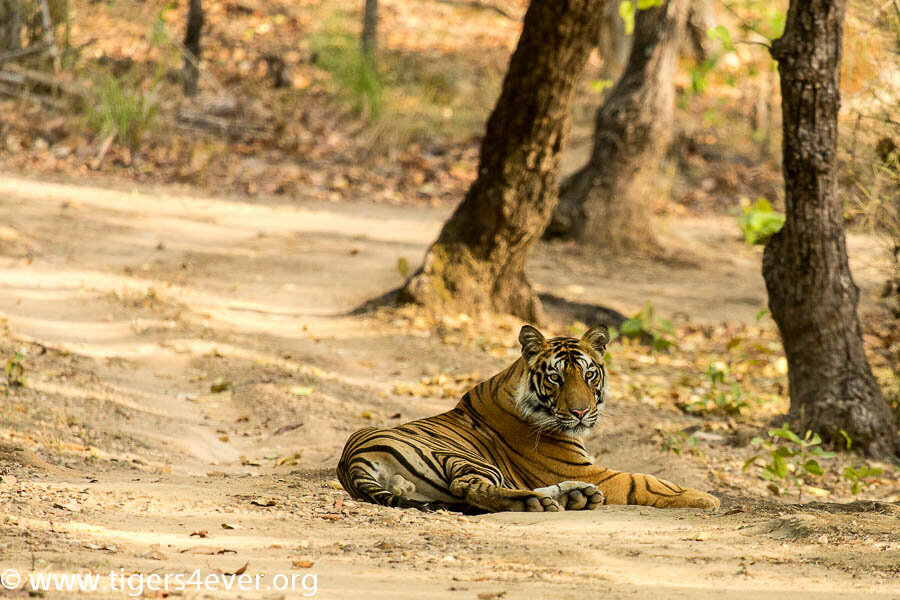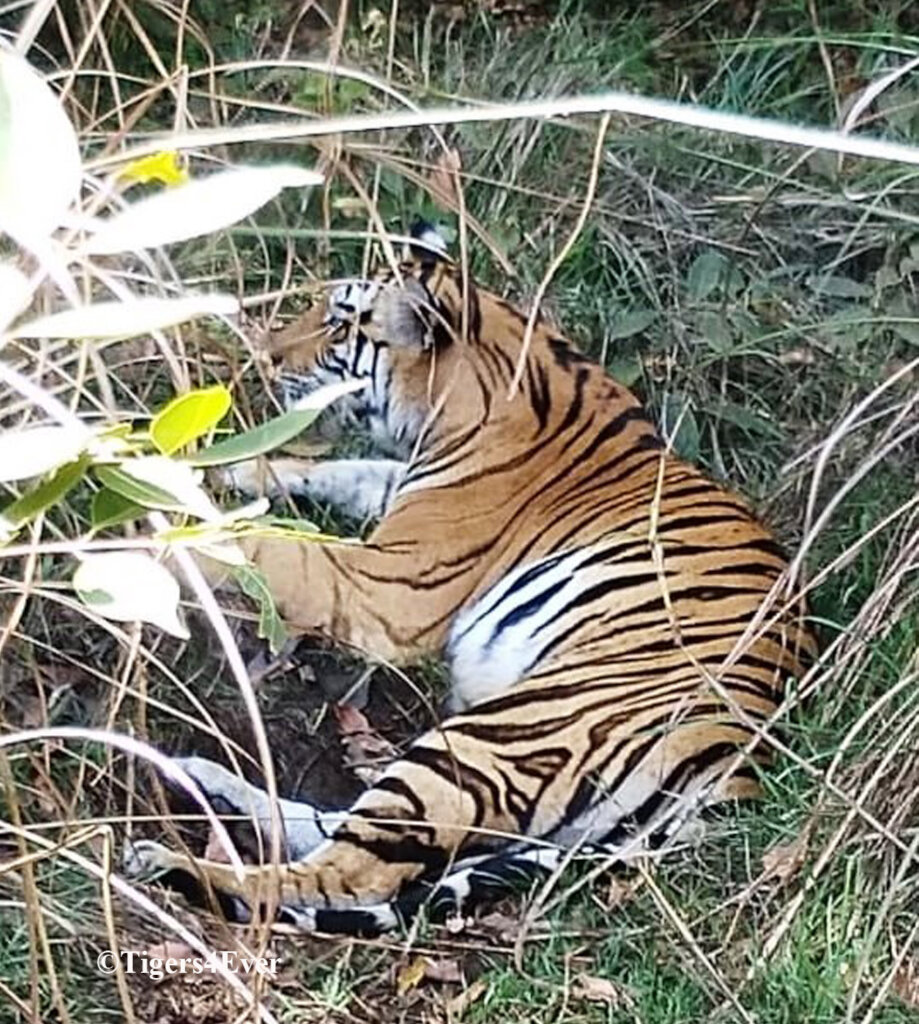By Dr. Corinne Taylor-Smith | Project Leader
In these challenging times as the cost of living crisis grips many of us, we are eternally grateful for your continued incredible support, so thank you from the bottom of our hearts. Without your help we’d already be reducing our Anti-Poaching Patrols to ensure that we can keep going throughout 2023. Your generosity helped us to undertake treble-patrolling during the festive season, when poachers often strike. Without your help this additional patrolling would be impossible. Your donations ensure that the growing wild tiger and cubs population is getting the best protection we can currently provide.
Colder Winters are Here
Since 2019, we have seen winter temperatures plummet to record low levels in Bandhavgarh. Early morning and overnight temperatures now fall as low as 2°C (35°F) which is some 5°C (12°F) lower than the previous average for this time of year. In the last three weeks this has resulted in dense foggy conditions with visibility as low as 2 metres (6.5 feet) which makes patrolling conditions very dangerous for on-foot patrolling. Our patrols need to be extra vigilant at these times to avoid stepping into poachers’ snares and traps, or stumbling upon a resting or feeding tiger or leopard. Greater reliance is placed on sensory detection, such as the aroma of a fresh or older kill, the detection of fresh pugmarks, the rustling of leaves or grasses, etc. All our patrollers are issued strong wooden canes which are extremely useful for checking dense undergrowth for tethered or traditional snares. It’s hard to appreciate sometimes that a simple wooden cane costing less than £10 (US$13) can save an anti-poaching patroller’s life or leg! Such equipment is absolutely vital year round.
The colder weather has other impacts on our patrollers too. This winter, we provided new thicker heavy duty warm jackets for 205 (of more than 1000) anti-poaching patrollers, to supplement the warm socks and winter boots previously provided. This is a start, but we still need to raise a further £16000 (US$20800) to enable the remaining 800 patrollers, who struggle to cope with the biting cold whilst on their foot patrols, to have warm winter jackets too. These brave men and women risk their lives to keep wild tigers safe, and rarely complain, but the cold weather is getting to them now. We need to raise these funds this year so we can ensure that every patroller can carry out their vital duties as the freezing temperatures persist.
Without this vital equipment, vital patrolling will cover shorter distances as the temperatures plummet: leaving wild tigers and their cubs vulnerable to poachers’ snares and traps. If those of you who live in northern Europe, or the Northern US states and Canada can imagine walking around outside on a January morning in just a T-shirt and summer trousers, then staying outside dressed like that for up to 12 hours, it will give an indication of the challenges face by the anti-poaching patrols right now. We think that many of you would go inside or put a coat on long before the first hour was up, let alone 12 hours? That’s why we can’t expect the patrollers to stay outside all night in the freezing cold either. Where possible we’re trying to get each jacket shared by two patrollers (one day shift/one night shift) but this isn’t a long term solution as the colder temperatures persist for longer each day. If you can help, each heavy duty warm winter jacket costs just £20 ($25) https://goto.gg/56553 and will not only keep a patroller protecting wild tigers for 12 hours per day but will provide much needed employment for up to 4 people living with wild tigers who make and distribute the jackets too.
Wildlife and Human Casualties
Over the last two months we have witnessed an increase in both human-wildlife conflict and Tiger wildlife conflict around Bandhavgarh. This conflict has resulted in deaths of both leopards and humans by an increased population of wild tigers. The end of November was a particularly worrying time as a tiger killed an 18 year old boy who wandered into the core forest alone. During the same weekend two different tigers killed 3 leopards in territorial battles. Then last weekend, in another area of Bandhavgarh, a tiger killed a young boy of 15 as he walked through a farmed field to reach his father at dusk. In a separate incident, a tiger killed a family of four leopards including both parents and two cubs. As wild tiger populations grow and struggle to find sufficient territory to call home, incidents like these will become more commonplace until more water and habitat can be provided to reduce the conflict. We are currently in the process of providing two more permanent wildlife waterholes, although work has been halted in recent weeks due to foggy conditions threatening the safety of the workers and the rangers who provide protection whilst work is underway. As soon as the temperatures increase, and the foggy days are gone, work will resume to complete these waterholes, and identify further new sites https://goto.gg/34315.
When these incidents are coupled with the increased risk of poaching activities, it means that our patrollers must be on high alert at all times. We must, therefore, ensure that we can maintain a minimum of tripled patrolling especially throughout the winter period when poachers are notoriously active. https://goto.gg/28767.
Increasing Awareness
Last year we recruited more volunteers, including some in India, who’ve helped to distribute education packs to the children in rural villages and to gather new ideas to help educate these children about the importance of wild tigers and their forest home. We continue to work with our new volunteers to ensure that learning about the forest and the wildlife within it will be fun for the children who will provide the next generation of wild tiger protectors.
We’re also developing new volunteering partnerships which will enable us to create bi-lingual educational resources with infographics on forest safety and protection for all age groups, to be distributed by our anti-poaching patrollers when patrolling around villages and encountering villagers in the forest. We also hope to develop an audio resource which can be delivered by volunteers in the villages as part of a wider awareness and environmental protection programme.
What Else are We Doing to Help?
After seven and a half long, hard years of patrolling, some of the vital patrolling equipment and clothing we’ve provided to help our anti-poaching patrols to keep wild tigers safe has worn-out. We managed to provide urgently needed waterproof clothing and boots to protect 400 anti-poaching patrollers during the heavy monsoon rains. However, we still need to raise funds for a further 600 sets of waterproof clothing and boots (£12150/US$14900), before the onset of the next monsoon. Any assistance you can give will be most welcome: https://goto.gg/56553. Even the smallest donation will be a huge help in these difficult times.
Making a Difference
Thanks to your continued support, we can cover an extra 1000 km (624 miles) of wild tiger territory per month with our trebled patrols. Without the vital equipment needed to beat the current weather conditions, this may reduce until the warmer weather returns. During the colder weather, it is essential to ensure sufficient time to search for snares; traps and signs of poisoners around forest areas where human encroachment is widespread as poachers are more active. We also need to maintain our patrols around the periphery of villages where crop raiding and livestock killing is also rife. Our increased patrolling helps us to curb human encroachment into wild tigers’ territories, and allows us to provide safety advice for those trying to protect their crops and livestock from wandering elephants and tigers respectively.
With more than 60 tiger cubs under 18 months old, we have many more wild tigers to keep safe, so your help is crucial. Your gift today, however large or small can make a huge difference as to whether Bandhavgarh’s wild tigers can survive the unprecedented threats they face:
Making your Gift Count Twice
Your new online monthly gift of £12 (US$15) per month won’t just help us to pay an anti-poaching patroller protecting wild tigers for 35 days per year; it will also qualify for a 100% match bonus on the first donation amount if you keep donating for 4 months or longer. That means when you donate at £12 (US$15) monthly in month 4 we will receive an extra £12 (US$15) from GlobalGiving to help us save wild tigers. Thus there has never been a better time to start a new monthly donation than now. (https://www.globalgiving.org/projects/saving-bandhavgarhs-wild-tigers/?show=recurring). As this project is nearly funded, we are asking for new donations to our main anti-poaching patrols project: https://goto.gg/28767 which will continue for as long as we are able to do the patrolling.
Without our help, we know that more wild tigers will die; and more humans will be mauled or killed due to encroachment or human-tiger conflict. Sadly, with every human life lost comes another threat to the wild tiger’s survival in the form of retaliation; thus we must protect both if we are to ensure that wild tigers can have a wild future.
Please don’t hesitate if you can help, your donation can be the difference between life and death for a wild tiger, as it helps to increase our patrolling when it is most needed. Every tiger and every tiger cub counts. Thank you for making our fight against poachers, the changing climate and human-animal conflict possible. (https://goto.gg/28767).
Links:
By Dr. Corinne Taylor-Smith | Project Leader
By Dr. Corinne Taylor-Smith | Project Leader
Project reports on GlobalGiving are posted directly to globalgiving.org by Project Leaders as they are completed, generally every 3-4 months. To protect the integrity of these documents, GlobalGiving does not alter them; therefore you may find some language or formatting issues.
If you donate to this project or have donated to this project, you can receive an email when this project posts a report. You can also subscribe for reports without donating.
Support this important cause by creating a personalized fundraising page.
Start a Fundraiser

